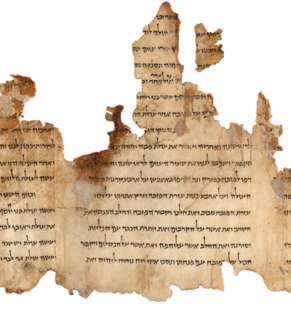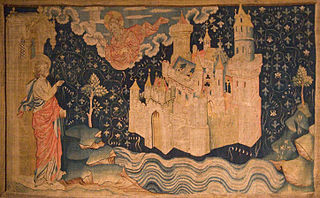
Qumran is an archaeological site in the West Bank managed by Israel's Qumran National Park. It is located on a dry marl plateau about 1.5 km (1 mi) from the northwestern shore of the Dead Sea, near the Israeli settlement and kibbutz of Kalya. The Hellenistic period settlement was constructed during the reign of John Hyrcanus (134–104 BCE) or somewhat later, and was occupied most of the time until it was destroyed by the Romans in 68 CE or shortly after. It is best known as the settlement nearest to the Qumran Caves where the Dead Sea Scrolls were hidden, caves in the sheer desert cliffs and beneath, in the marl terrace. The principal excavations at Qumran were conducted by Roland de Vaux in the 1950s, though several later unearthings at the site have since been carried out.

Emanuel Tov is emeritus Professor in the Department of Bible at the Hebrew University of Jerusalem.

The Temple Scroll is the longest of the Dead Sea Scrolls. Among the discoveries at Qumran it is designated: 11QTemple Scrolla(11Q19[11QTa]). It describes a Jewish temple which was never built, along with extensive detailed regulations about sacrifices and temple practices. The document is written in the form of a revelation from God to Moses, thereby with the intended meaning that this is the more appropriate temple which was revealed to Moses, and that Moses' instructions were either forgotten or ignored when Solomon built the First Temple. In other words, in the mind of the Scroll writer, "Solomon should actually have built the First Temple as it is described here in the Temple Scroll".
Discoveries in the Judaean Desert is the official, 40-volume, publication series that serves as the editio princeps for the Dead Sea Scrolls. It is published by Oxford University Press.

Wicked Priest is a sobriquet used in the Dead Sea Scrolls pesharim, four times in the Habakkuk Commentary (1QpHab) and once in the Commentary on Psalm 37 (4QpPsa), to refer to an opponent of the "Teacher of Righteousness." It has been suggested that the phrase is a pun on "ha-kōhēn hā-rōš", as meaning "the High Priest", but this is not the proper term for the High Priest. He is generally identified with a Hasmonean (Maccabean) High Priest or Priests. However, his exact identification remains controversial, and has been called "one of the knottiest problems connected with the Dead Sea Scrolls."

Who Wrote The Dead Sea Scrolls?: The Search For The Secret Of Qumran is a book by Norman Golb which intensifies the debate over the origins of the Dead Sea Scrolls, furthering the opinion that the scrolls were not the work of the Essenes, as other scholars claim, but written in Jerusalem and moved to Qumran in anticipation of the Roman siege in 70 AD.
Donald W. Parry Ph.D. is a professor of Hebrew Bible in the Department of Asian and Near Eastern Languages at Brigham Young University. He holds the Abraham O. Smoot Professorship. He is the author and editor of many works related to the Dead Sea Scrolls and the Old Testament. He has been a member of the International Team of Translators of the Dead Sea Scrolls since January 1994. He also serves as a member of the Dead Sea Scrolls Foundation Board of Advisors, 2008–present.
Florentino García Martínez is a former Catholic priest, now married and for many years professor of religion and theology at the University of Groningen in the Netherlands. He is a leading expert on messianic ideas in the Dead Sea scrolls.
The Isaiah Scroll, designated 1Qlsaa and also known as the Great Isaiah Scroll, is one of the seven Dead Sea Scrolls that were first recovered by Bedouin shepherds in 1947 from Qumran Cave 1. The scroll is written in Hebrew and contains the entire Book of Isaiah from beginning to end, apart from a few small damaged portions. It is the oldest complete copy of the Book of Isaiah, being approximately 1000 years older than the oldest Hebrew manuscripts known before the scrolls' discovery. 1QIsaa is also notable in being the only scroll from the Qumran Caves to be preserved almost in its entirety.

The Genesis Apocryphon (1Q20), also called the Tales of the Patriarchs or the Apocalypse of Lamech and labeled 1QapGen, is one of the original seven Dead Sea Scrolls discovered in 1946 by Bedouin shepherds in Cave 1 near Qumran, a city in the northwest corner of the Dead Sea. Composed in Aramaic, it consists of four sheets of leather. Furthermore, it is the least well-preserved document of the original seven. The document records a pseudepigraphal conversation between the biblical figure Lamech, son of Methuselah, and his son, Noah, as well as first and third person narratives associated with Abraham. It is thought to possibly serve as an example of an expanded and rewritten biblical story. A range of compositional dates for the work have been suggested from the 3rd century BCE to 1st century CE. Palaeography and Carbon-14 dating were used to identify the age of the documents. It is 13 inches in length and 2.75 inches in width at its widest point in the middle.
Joseph M. Baumgarten was a Semitic scholar known for his knowledge in the field of Jewish legal texts from biblical law to Mishnaic law and including the legal texts among the Dead Sea Scrolls.
Baumgarten immigrated to the United States with his family in 1939 as a result of the Anschluss, Germany's occupation of Austria in 1938. In 1950, he was ordained a rabbi at Mesivta Torah Vodaath, a prominent Brooklyn yeshiva. He married Naomi Rosenberg in 1953.

Qumran Caves are a series of caves, some natural, some artificial, found around the archaeological site of Qumran in the Judaean Desert of the West Bank. It is in these caves that the Dead Sea Scrolls were discovered. The caves are recognized in Israel as a National Heritage Site, despite the caves being in occupied Palestinian territories; as such, the designation has drawn criticism.
4Q448, often called the "Hymn to King Jonathan," is a piece of parchment from among the Dead Sea Scrolls, found in Cave 4, containing two separate short works, part of Psalm 154 and a prayer mentioning King Jonathan.
Carbon dating the Dead Sea Scrolls refers to a series of radiocarbon dating tests performed on the Dead Sea Scrolls, first by the AMS lab of the Zurich Institute of Technology in 1991 and then by the AMS Facility at the University of Arizona in Tucson in 1994-95. There was also a historical test of a piece of linen performed in 1946 by Willard Libby, the inventor of the dating method.
4QInstruction, or Sapiential Work A, is a document that is preserved in at least seven fragmentary manuscripts from the Dead Sea Scrolls; these are 4Q415, 4Q416, 4Q417, 4Q418, 4Q418a, 4Q423, and 1Q26. Cave 1 materials were first published by Józef Milik in DJD 1 in 1955. Cave 4 materials were published in the Discoveries in the Judean Desert series in 1999 by John Strugnell and Daniel Harrington. The document is written in Hebrew, is likely to be categorized as "non-sectarian" or perhaps "pre-sectarian". There is some consensus that it dates to the third century BCE.
4Q521 or the 4QMessianic Apocalypse is one of the Dead Sea Scrolls found in the Cave 4 near Qumran.
Francisco Juan Martínez Mojica, usually known as Francisco JM Mojica, is a Spanish microbiologist at the University of Alicante in Spain, known for his research on the CRISPR gene editing technique.
![Dead Sea Scrolls Ancient Jewish religious, mostly Hebrew, manuscripts found in the Qumran Caves in the West Bank] near the Dead Sea](https://upload.wikimedia.org/wikipedia/commons/thumb/d/d4/Flag_of_Israel.svg/320px-Flag_of_Israel.svg.png)







